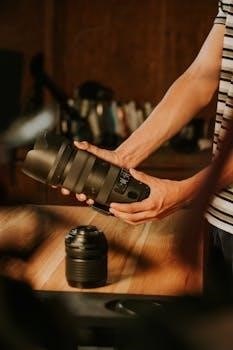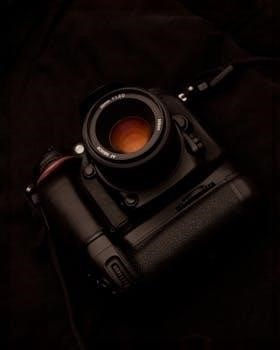Nikon D7200 Instruction Manual⁚ A Comprehensive Guide
Unlocking the full potential of your Nikon D7200 requires a comprehensive understanding of its features. This guide will navigate you through everything, from basic setup to advanced customization.
Understanding the Basics
Before diving into advanced techniques, familiarize yourself with the Nikon D7200’s fundamental components. Grasp the function of dials, buttons, and menu navigation. Understand how to power on/off the camera, insert/remove memory cards, and attach/detach lenses. Learn to navigate the information display, interpreting key shooting data. This initial understanding forms the bedrock of your photographic journey. Explore the camera’s physical layout and become comfortable with its basic operation. Practice these steps repeatedly to build muscle memory and confidently operate your D7200 in any shooting situation. This foundational knowledge is essential for capturing stunning images.
Getting Started with Your Nikon D7200
Let’s power up your Nikon D7200 and prepare it for its first shoot! We’ll cover initial settings, battery charging, and essential setup configurations.
Initial Setup and Configuration
Begin by inserting the battery and memory card into your Nikon D7200. Next, power on the camera and navigate to the menu system to set the date, time, and language. These initial configurations are crucial for organizing your photos and ensuring accurate timestamps. Customize the information display to show relevant shooting data. Familiarize yourself with the menu layout and basic navigation. Consider setting up your preferred image quality and size settings. You can explore options like RAW or JPEG and choose appropriate resolutions for your needs. Correct setup ensures optimum performance.

Exploring Shooting Modes
The Nikon D7200 offers a range of shooting modes, providing flexibility for various scenarios. Understanding these modes is key to capturing the perfect shot in any situation.
Auto, Program, Shutter Priority, Aperture Priority, and Manual (PASM) Modes
The Nikon D7200 gives you ultimate control with its PASM modes. Auto mode simplifies shooting, while Program mode allows the camera to set aperture and shutter speed automatically, with the option to change them. Shutter Priority lets you control motion blur, while Aperture Priority controls depth of field. For complete creative freedom, Manual mode enables full control over both aperture and shutter speed. Mastering these modes is essential for unlocking the D7200’s full photographic potential and capturing images exactly as you envision them. Experiment and find which works best!
Understanding Scene Modes
The Nikon D7200 offers a variety of scene modes designed for specific shooting situations, simplifying the process of capturing optimal images. These modes automatically adjust camera settings such as aperture, shutter speed, and white balance to suit the scene. Common scene modes include Portrait, Landscape, Child, Sports, Close-up, and Night Portrait. Using scene modes is an excellent way for beginners to achieve great results quickly. While experienced photographers may prefer manual control, scene modes provide a convenient starting point or a quick solution in challenging conditions. Explore each mode to see what it offers for your photography.

Focusing and Metering
Achieving sharp focus and accurate exposure are crucial for great photos. The D7200 provides versatile focusing and metering systems. Understanding these systems is key to mastering your camera.
Focus Modes and Area Modes
The Nikon D7200 offers a range of focus modes to suit various shooting situations. Single-servo AF (AF-S) is ideal for stationary subjects, while continuous-servo AF (AF-C) tracks moving subjects. Manual focus (MF) provides complete control. Understanding when to use each mode is essential.
Furthermore, the D7200 features different AF-area modes. Single-point AF allows precise focusing on a specific point. Dynamic-area AF uses surrounding focus points to maintain focus on moving subjects. Auto-area AF automatically selects the focus points. Choosing the right combination ensures sharp, well-focused images. These settings can be found in the camera’s menu system.
Metering Modes Explained
The Nikon D7200 employs sophisticated metering systems to determine the optimal exposure for your photographs. Understanding these modes is crucial for achieving well-balanced images in various lighting conditions. Matrix metering evaluates the entire scene, considering brightness, color, and distance, to deliver accurate exposure in most situations.
Center-weighted metering emphasizes the center of the frame, useful for portraits or subjects where the center is most important. Spot metering measures the light at a very small point, allowing precise exposure control for high-contrast scenes. Highlight-weighted metering prioritizes highlight detail, preventing blown-out highlights in challenging lighting. Selecting the appropriate metering mode improves your photography.

Image Quality and Settings
Optimizing image quality on your Nikon D7200 involves understanding resolution, file formats, white balance, and ISO. Mastering these settings allows you to capture stunning, high-quality images in diverse shooting scenarios.
Understanding Resolution and File Formats (RAW vs. JPEG)
The Nikon D7200 offers various resolution settings impacting image detail and file size. Choosing the right resolution depends on your intended use, balancing detail with storage capacity. Understanding file formats, particularly RAW versus JPEG, is crucial. RAW files retain all captured data, offering maximum editing flexibility but require post-processing. JPEG files are compressed, resulting in smaller sizes but with some loss of detail. Selecting between RAW and JPEG depends on your workflow, storage considerations, and desired level of post-processing control. Experimenting with both helps determine the best option for your needs.
White Balance and ISO Settings
Mastering white balance and ISO settings is essential for achieving accurate colors and optimal image brightness on your Nikon D7200. White balance corrects color casts caused by different lighting conditions, ensuring true-to-life colors. Experiment with preset modes like “Daylight,” “Cloudy,” and “Fluorescent,” or use custom white balance for precise control. ISO determines the camera’s sensitivity to light. Lower ISO values produce cleaner images in bright conditions, while higher ISOs are necessary in low light but can introduce noise. Understanding the interplay between these settings is key to capturing well-exposed and visually appealing photographs in any situation.
Video Recording
The Nikon D7200 offers Full HD video recording capabilities. This section explores the settings and considerations for capturing high-quality videos, ensuring you get the most out of your camera’s video functions.
Full HD Video Capabilities
The Nikon D7200 empowers users to record stunning Full HD videos at 1920×1080 resolution, with frame rates up to 60 frames per second. Explore the camera’s ability to capture smooth, detailed footage, suitable for various applications from personal memories to professional projects. Discover the settings to fine-tune video quality, control audio levels, and utilize manual focus for cinematic effects. Learn about different recording modes, including time-lapse and slow-motion options. Understand how to leverage external microphones and headphones for enhanced audio capture and monitoring, ultimately maximizing the D7200’s video potential.
Video Settings and Considerations
Optimizing video recording on the Nikon D7200 involves careful consideration of several settings. Understand the impact of frame rate on the final product, balancing smoothness with file size. Master aperture and shutter speed adjustments for depth of field and motion blur control. Explore ISO settings to manage low-light performance while minimizing noise. Learn about picture controls to adjust the overall look and feel of your video footage. Consider external audio solutions for better sound quality. Grasp the importance of proper white balance for accurate color representation. Experiment with different video modes to discover the best approach for various subjects.

Customization and Advanced Features
Dive into the Nikon D7200’s advanced capabilities to tailor the camera to your specific needs. Explore custom settings, Wi-Fi connectivity, and other features beyond basic operation.
Custom Settings Menu
The Nikon D7200’s Custom Settings Menu allows photographers to fine-tune camera behavior to match their preferences and shooting styles. This powerful section of the menu lets you adjust everything from autofocus responsiveness and button assignments to exposure compensation steps and bracketing orders. Understanding and utilizing these settings unlocks a new level of control, enabling you to optimize the D7200 for specific genres like sports, portraiture, or landscape photography. Mastering the Custom Settings Menu is essential for experienced users who want to maximize the camera’s capabilities and create a truly personalized shooting experience.
Using the Built-in Wi-Fi
The Nikon D7200’s built-in Wi-Fi capability allows for seamless image transfer and remote camera control. To utilize this feature, you’ll first need to establish a connection with your smart device via Nikon’s Wireless Mobile Utility app. Once connected, you can wirelessly transfer photos and videos to your smartphone or tablet for easy sharing on social media or backup purposes. The app also enables remote shooting, giving you control over shutter release and other settings from a distance, which is useful for self-portraits or wildlife photography. Explore the possibilities with this handy feature.
Troubleshooting and Maintenance
Like any sophisticated camera, the Nikon D7200 may encounter issues. Regular maintenance ensures longevity. This section provides solutions to common problems and guides proper cleaning/storage practices.
Common Issues and Solutions
The Nikon D7200, while robust, may occasionally present challenges. Addressing these promptly can prevent further complications. One common issue is focusing errors, often resolved by checking focus mode settings or cleaning lens contacts. Another concern is battery drain, typically mitigated by reducing LCD brightness or disabling Wi-Fi when not in use. Image corruption could stem from faulty SD cards, so try a different one. Error messages are valuable clues, consult the official manual linked for specific codes. Software glitches might require a firmware update to resolve compatibility problems. Overheating may occur during extended video recording.
Cleaning and Storage
Proper care ensures the longevity of your Nikon D7200. Before cleaning, power off the camera and remove the lens. Use a soft, dry microfiber cloth to gently wipe the body and LCD screen. For stubborn smudges, dampen the cloth slightly with a lens cleaning solution. Clean the lens elements with a lens brush and lens cleaning fluid, applying it to the cloth, not directly to the lens. Store the camera in a cool, dry place, away from direct sunlight and dust. Consider using a camera bag or airtight container with desiccant to absorb moisture.

